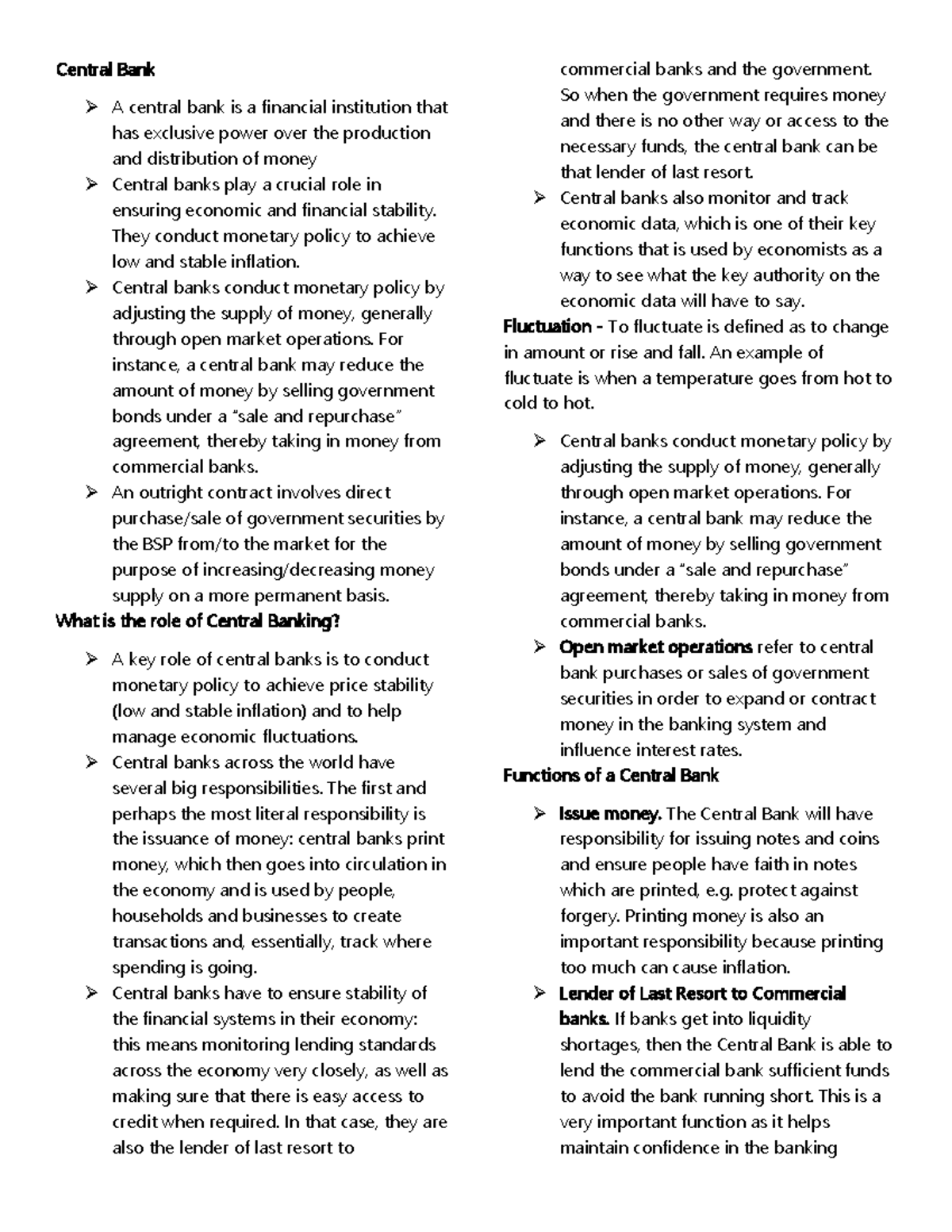Is Central Bank: Monetary Policy, Financial Stability, And Economic Growth a topic of your concern?
Editor's Notes: "Central Bank: Monetary Policy, Financial Stability, And Economic Growth" have published today. It is important to read as it affects a country's economy.

Growing Tree and Golden Coins. Financial Stability, Economic Growth - Source www.dreamstime.com
We have made a deep study and analysis on this topic. Here, we put together this Central Bank: Monetary Policy, Financial Stability, And Economic Growth guide to help you make the right decision.
Key differences or Key takeways
| Central Bank: Monetary Policy | Financial Stability | Economic Growth |
|---|---|---|
| Central bank's role in controlling money supply and interest rates. | Maintaining a sound and stable financial system. | Promoting sustainable economic growth. |
| Tools: open market operations, reserve requirements, discount rate. | Tools: regulation, supervision, and crisis management. | Tools: fiscal policy, monetary policy, and structural reforms. |
Transition to main article topics
FAQ
This FAQ section addresses commonly raised questions and misconceptions regarding the central bank's role in monetary policy, financial stability, and economic growth.

illustration of dollar and coin on economic growth. career and increase - Source www.vecteezy.com
Question 1: What is the primary objective of a central bank's monetary policy?
Answer: Central banks primarily focus on maintaining price stability and fostering economic growth. They use tools such as interest rate adjustments and quantitative easing to influence the supply of money and credit, thereby managing inflation and achieving economic objectives.
Question 2: How does financial stability impact economic growth?
Answer: Financial stability is crucial for sustainable economic growth. A stable financial system ensures the efficient flow of funds throughout the economy, supports investment and innovation, and reduces the risk of financial crises that can disrupt economic activity.
Question 3: What are the main functions of a central bank in promoting economic growth?
Answer: Central banks contribute to economic growth by setting interest rates, managing inflation, and ensuring financial sector stability. They also facilitate payment systems, regulate banks, and provide policy advice to governments.
Question 4: How does monetary policy affect inflation?
Answer: Monetary policy, particularly the manipulation of interest rates, influences the supply of money and credit in the economy. Changes in interest rates can affect inflation by influencing spending, investment, and borrowing patterns.
Question 5: What factors contribute to financial instability?
Answer: Financial instability can arise from various factors, including excessive risk-taking by financial institutions, asset price bubbles, and external shocks such as economic downturns. Central banks monitor and address these risks to maintain financial system stability.
Question 6: How does a central bank regulate financial institutions?
Answer: Central banks implement regulations and policies to oversee financial institutions. These regulations set capital requirements, risk management standards, and reporting guidelines to ensure the soundness and integrity of the financial system.
In summary, the central bank plays a critical role in maintaining monetary policy, financial stability, and fostering economic growth. Its functions and policies aim to achieve these objectives, contributing to the overall stability and prosperity of the economy.
Tips
This article, Central Bank: Monetary Policy, Financial Stability, And Economic Growth, provides insights into the importance of monetary policy. Here are some tips to keep in mind:
Tip 1: Understand the role of central banks
Central banks play a crucial role in maintaining price stability, promoting financial stability, and supporting economic growth. They set interest rates, manage the money supply, and regulate financial institutions.
Tip 2: Monitor monetary policy decisions
Central banks make decisions that can significantly impact the economy. It is crucial to monitor these decisions, such as interest rate announcements and policy statements, to understand how they may affect your finances.
Tip 3: Consider the impact of monetary policy on inflation
Monetary policy can influence inflation rates. Higher interest rates tend to curb inflation, while lower rates may stimulate inflation. Understanding this relationship can help you make informed financial decisions.
Tip 4: Recognize the role of monetary policy in financial stability
Central banks use monetary policy to promote financial stability. They aim to prevent excessive risk-taking and bubbles in financial markets, which can lead to economic instability.
Tip 5: Appreciate the importance of monetary policy for economic growth
Monetary policy can support economic growth by creating a stable and conducive environment for businesses and investment. It can influence factors such as consumer spending, business investment, and job creation.
Summary:
Understanding monetary policy and its impact can help you make better financial decisions and stay informed about economic developments.
Central Bank: Monetary Policy, Financial Stability, And Economic Growth
The central bank's primary functions, encompassing monetary policy, financial stability, and economic growth, shape the financial landscape and exert a profound influence on economic activity.
- Monetary Policy Influences: Interest rates, inflation, liquidity
- Financial Stability: Systemic risks, market regulation, crisis management
- Economic Growth Facilitates: Business investment, job creation, productivity
- Central Bank Independence: Autonomy to make monetary policy decisions
- Objective: Price stability and economic prosperity
- Tools of Monetary Policy: Open market operations, reserve requirements, discount rate
These aspects are deeply interconnected. Monetary policy tools adjust interest rates, which impact financial markets and influence economic growth. Financial stability measures aim to prevent systemic crises that could hinder economic progress. Central bank independence ensures objective decision-making, which fosters trust and supports economic growth. The interplay of these key aspects allows central banks to fulfill their crucial role in fostering a sound and stable financial system that supports economic growth and prosperity.

Central BANK - Monetary Policy - Central Bank A central bank is a - Source www.studocu.com
Central Bank: Monetary Policy, Financial Stability, And Economic Growth
The connection between Central Bank's monetary policy, financial stability, and economic growth is multifaceted. Central banks play a crucial role in managing the money supply, interest rates, and financial institutions to foster economic growth while maintaining price stability. The effectiveness of monetary policy relies on maintaining financial stability, which involves managing systemic risks in the financial system. A stable financial system promotes efficient capital allocation, supports investment, and facilitates economic growth.

Dadvan Yousuf’s Perspective on Central Banks and Interest Rate Hikes - Source www.getnews.info
Central banks utilize various monetary policy tools to influence economic activity. By adjusting interest rates, they can stimulate or contract borrowing and spending, affecting aggregate demand. Quantitative easing and other unconventional monetary policies can provide additional liquidity to the financial system during economic downturns. These measures aim to promote investment, boost growth, and mitigate financial instability.
Maintaining financial stability is equally important as monetary policy. Central banks supervise financial institutions, regulate systemic risks, and manage financial crises. By ensuring the soundness of the financial system, they prevent disruptions that could derail economic growth. Regulatory frameworks and stress tests help identify and mitigate risks, promoting confidence in the financial sector.
Governments and central banks must prioritize financial stability and economic growth. Sound monetary policies and robust financial regulation create an environment conducive to long-term growth. However, achieving this balance requires careful consideration of the potential trade-offs between price stability, financial stability, and economic growth.
Table: Summary of Key Points
| Aspect | Description |
|---|---|
| Monetary Policy | Central banks' use of interest rates and other tools to influence economic activity |
| Financial Stability | Stability of the financial system, minimizing systemic risks |
| Economic Growth | Expansion of economic output and prosperity |
| Connection | Monetary policy and financial stability support economic growth |
| Importance | Achieving balance among price stability, financial stability, and economic growth |
Conclusion
Central banks play a pivotal role in shaping the macroeconomic environment and fostering economic growth. By implementing sound monetary policy and maintaining financial stability, they provide the foundation for sustainable economic development. Understanding the interplay between these factors enables economists, policymakers, and individuals to make informed decisions that contribute to long-term prosperity.
As the global economy continues to evolve, central banks will need to adapt their policies to address new challenges. Balancing the goals of price stability, financial stability, and economic growth remains a complex task, requiring ongoing research, cooperation, and a commitment to evidence-based decision-making.